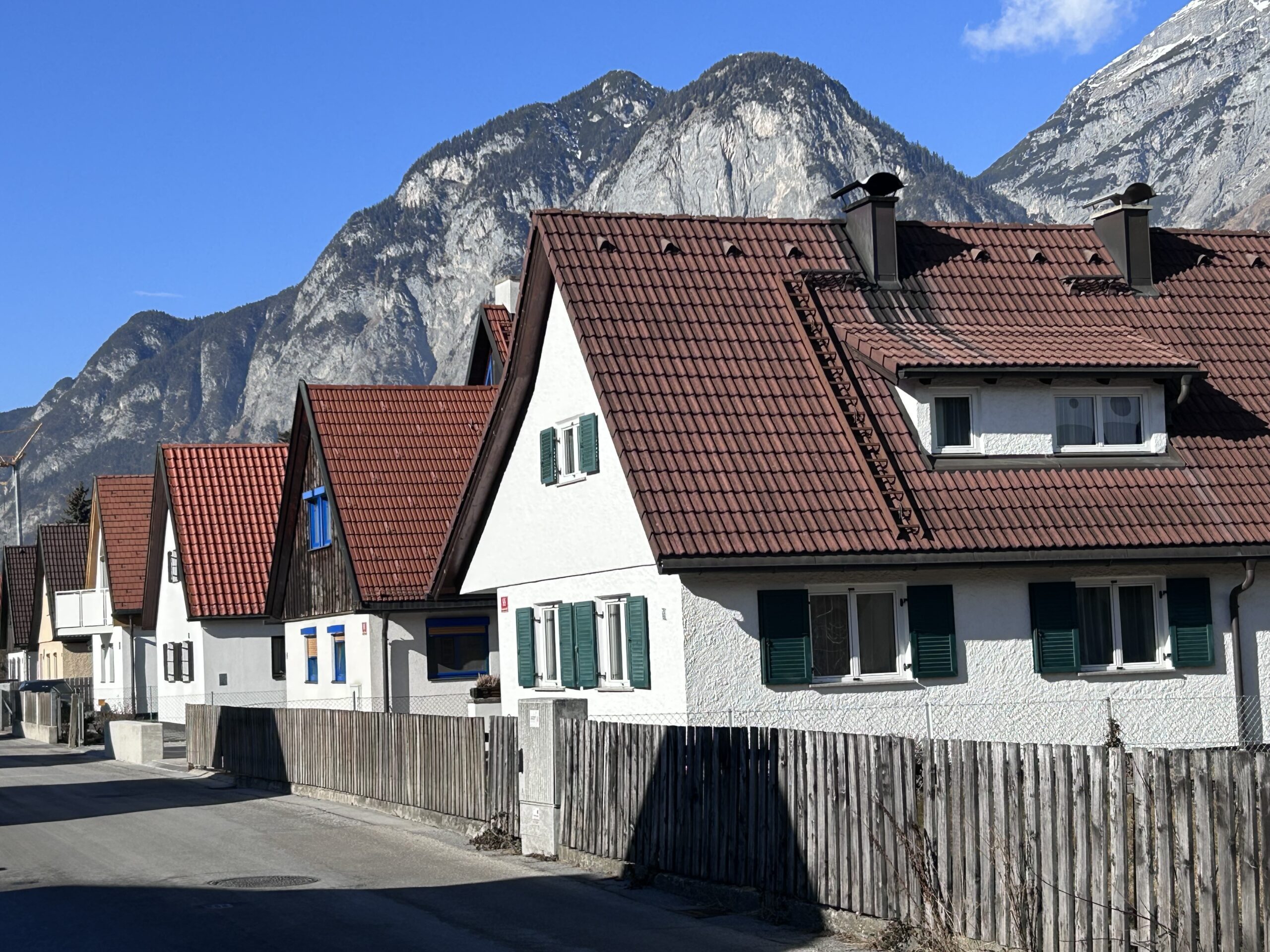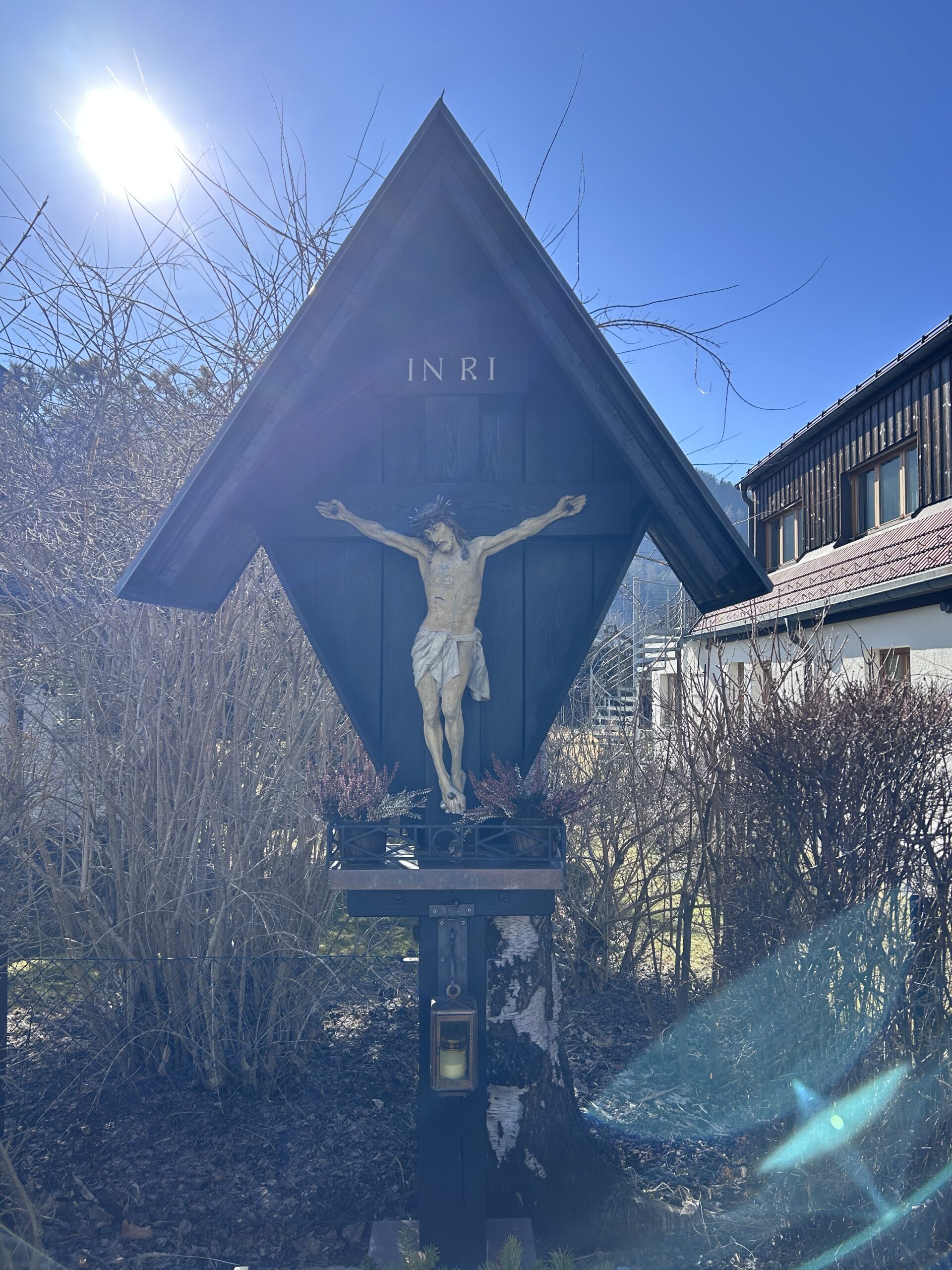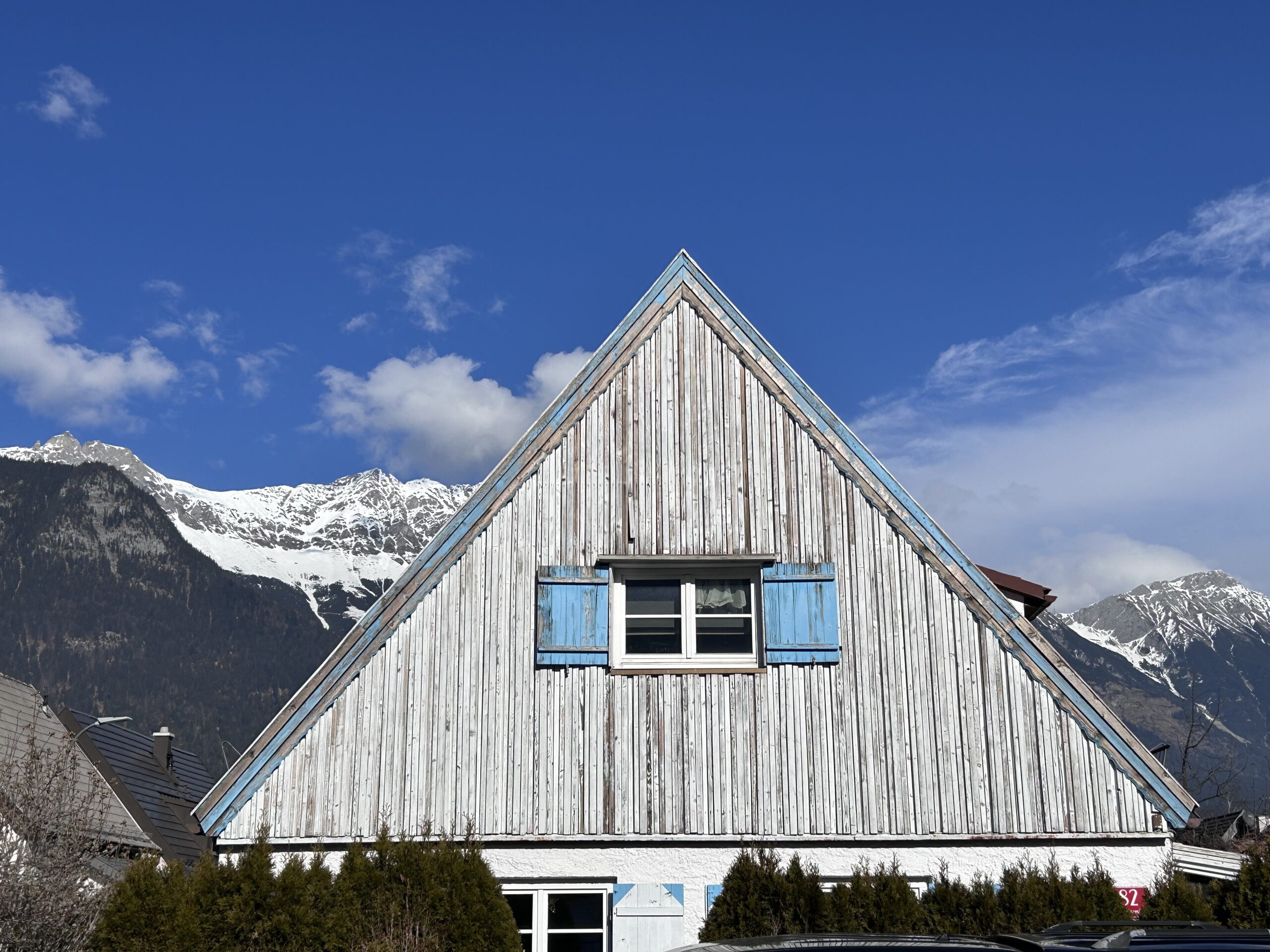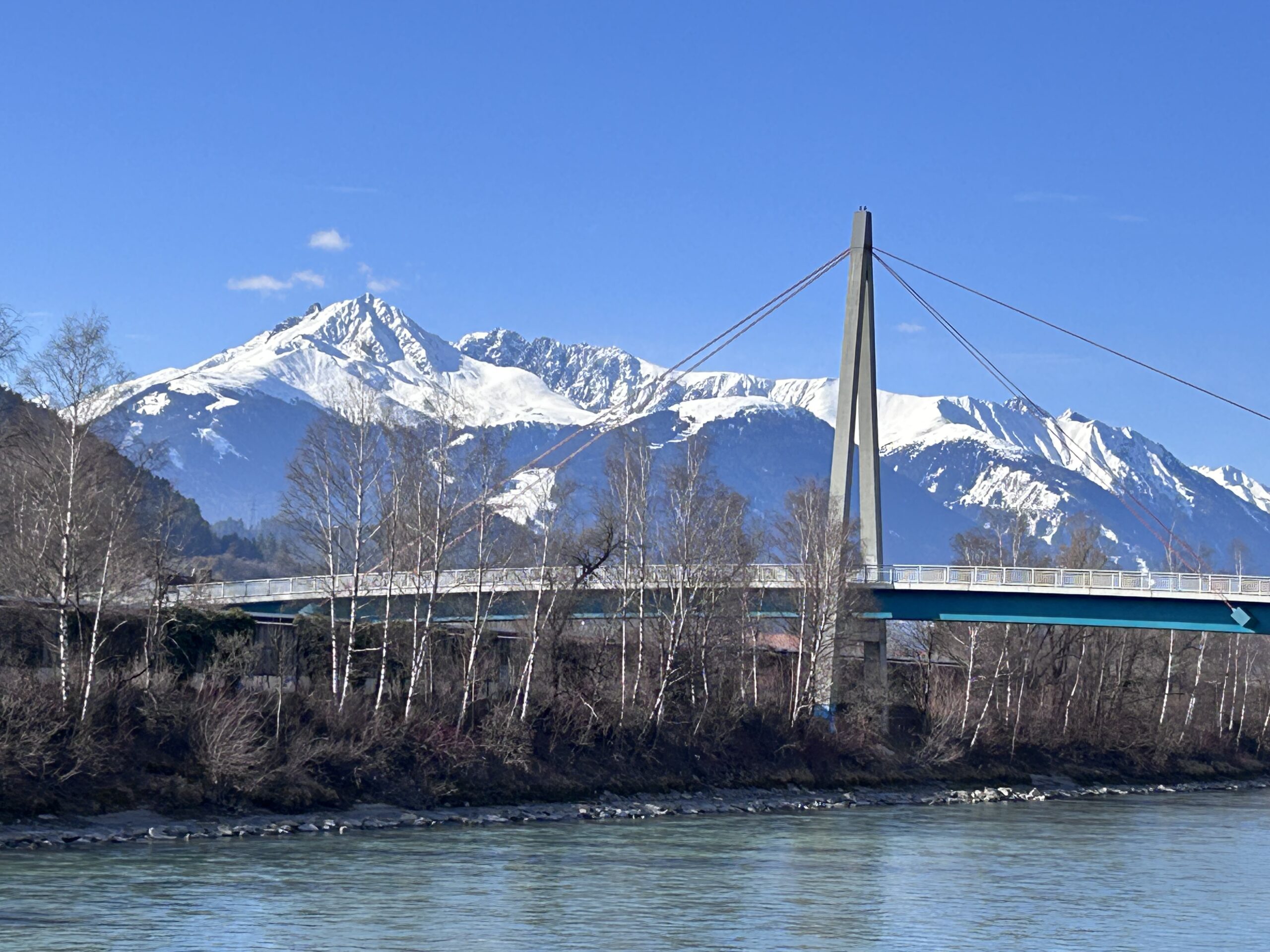Dollfußsiedlung & Fischersiedlung
Weingartnerstrasse
Worth knowing
The well-organised little houses in the housing estate in the west of the city with their front gardens on the quiet street are reminiscent of an American suburb from the 1950s. Unlike the suburbs on the other side of the Atlantic, however, Sieglanger was built before the war. At the beginning of the 1930s, when the misery of the Great Depression had also replaced the misery of the post-war period in Tyrol, the city of Innsbruck was faced with a dilemma. The city coffers were empty and at the same time the number of people moving to Innsbruck was increasing. People came to the city to find work, although unemployment here was also unimaginably high by today's standards. According to estimates, every fourth adult Austrian was unemployed in the early 1930s. Added to this was inflation, which had destroyed a great deal of wealth. Several shanty towns and houses, such as the Bocksiedlung, developed in a wild and disorganised manner.
In order to counteract the urban planning chaos, under Mayor Franz Fischer and Federal Chancellor Engelbert Dollfuß, municipal housing construction began to be promoted. However, this required the help of the Republic, as the municipality could not finance these plans on its own. Innsbruck was forced to finance the planned "Randsiedlungsaktionen für Erwerbslose zu Nebenerwerbszwecken" to be pre-financed by the Federal Housing and Settlement Fund.
The buildings that were erected reflected the basic intellectual attitude in the social policy of the Austrofascist regime of the Austrian corporative state under Chancellor Engelbert Dollfuß and his successor Kurt Schuschnigg. In contrast to the large buildings, which were constructed in the Red Vienna kamen und sich in Blöcken wie Burgen um Innenhöfe anordneten, sollten die kleinen, alleinstehenden Häuser mit Vorgarten eine ländliche Idylle simulieren. Zwischen den Häusern wurden Kleintierställe geplant, die zusammen mit den Gärten eine teilweise Selbstversorgung ermöglichten. Die bäuerliche Familie als katholische Keimzelle sollte dem sozialistischen Ideal der großen, republikanischen Gemeinschaft entgegenstehen. Sowohl architektonische wie auch ideologisch betrachtet war diese Siedlung im Westen der Stadt das Gegenteil von den Projekten in wie der Mandelsberger settlement in Wilten or the Pembaurblock in Pradl. The idea behind the Sieglanger was identical to that of US conservative politicians in the post-war period when it came to building new suburbs: property provides security, satisfaction and loyalty to the state.
The housing estates were built from 1934. As the city's building director, Jakob Alberts implemented this project without his social democratically orientated partner Theodor Prachensky, who was otherwise often consulted for the planning. The future residents helped to build their homes. Similar to the Höttinger Au housing estates after the Second World War, central self-catering gardens were also created. To be able to enjoy one of the coveted flats, you had to be a member of the Vaterländischen Frontthe all-determining unity party. One of the settlements was named after the mayor of Innsbruck, Franz Fischer, in Fishermen's settlement named. The second, which was built by Home from Siglanger No 61 - 93 was built, was named Dr-Dollfuß-Siedlung. In 1938, the National Socialist mayor Egon Denz baptised the little houses in Sieglangeriedlung um.
Despite many renovations and individual conversions, many of the little houses with their distinctive pointed roofs, which are otherwise mainly familiar from eastern Austria, have been preserved to this day. Sieglanger is no longer a social housing estate, but a middle-class neighbourhood on the western outskirts of Innsbruck. The association Traditional community Sieglanger carries the spirit and sense of community of the former settlers to the present day.
The Bocksiedlung and Austrofascism
In the First Republic, two large political and paramilitary blocs faced each other. The Republican Protection League on the side of the Social Democrats and the Christian-socially orientated Heimwehr, for the sake of simplicity the different groups are summarised under this collective term, were hostile to each other. Many politicians and functionaries on both sides, like a large proportion of the male population, had fought at the front during the war and were correspondingly militarised.
In Innsbruck, there were repeated small clashes between the opposing groups of Social Democrats, National Socialists and the Heimwehr. The so-called Höttinger Saalschlacht Hötting was not yet part of Innsbruck at that time. The community was mainly inhabited by labourers. In this red National Socialists planned a rally in the Tyrolean bastion at the Gasthof Golden Beara meeting place for the Social Democrats. This provocation ended in a fight that resulted in over 30 people being injured and one death from a stab wound on the National Socialist side. The riots spread throughout the city, with the injured even clashing in the hospital. Only with the help of the gendarmerie and the army was it possible to separate the opponents.
After years of civil war-like conditions, the Christian Socialists under Chancellor Engelbert Dollfuß (1892 - 1934) prevailed in 1933 and abolished parliament. Dollfuß's goal was to establish the so-called Austrian corporative statea one-party state without opposition, curtailing elementary rights such as freedom of the press and freedom of assembly. In Tyrol in 1933, the Tiroler Wochenzeitung was newly founded to function as a party organ. The entire state apparatus was to be organised along the lines of Mussolini's fascism in Italy under the Vaterländischen Front united: Anti-socialist, authoritarian, conservative in its view of society, anti-democratic, anti-Semitic and militarised.
Dollfuß was extremely popular in Tyrol, as photographs of the packed square in front of the Hofburg during one of his speeches in 1933 show. His policies were the closest thing to the Habsburg monarchy and were also supported by the Church. The Fatherland Front with its paramilitary units cracked down on socialists. The press was politically controlled and censored. The articles glorified the idyllic rural life. Families with many children were supported financially. The segregation of the sexes in schools and the reorganisation of the curriculum for girls, combined with pre-military training for boys, was also in the interests of a large part of the population. The unspoken long-term goal was the restoration of the monarchy. In 1931, a number of Tyrolean mayors joined forces to have the entry ban for the Habsburgs lifted.
On 25 July 1934, the banned National Socialists attempted a coup in Vienna, in which Dollfuß was killed. In Innsbruck, the "Verfügung des Regierungskommissärs der Landeshauptstadt Tirols“ der Platz vor dem Tiroler Landestheater als Dollfußplatz led. Dollfuß had met with the Tyrolean Heimwehr leader Richard Steidle at a rally here two weeks before his death.
Dollfuß' successor as Chancellor Kurt Schuschnigg (1897 - 1977) was a Tyrolean by birth and a member of the Innsbruck student fraternity Austria. Er betrieb lange Zeit eine Rechtsanwaltskanzlei in Innsbruck. 1930 gründete er eine paramilitärische Einheit mit namens Ostmärkische Sturmscharenwhich formed the counterweight of the Christian Socials to the radical Heimwehr groups. After the February Uprising in 1934, as Minister of Justice in the Dollfuß cabinet, he was jointly responsible for the execution of several Social Democrats.
However, Austrofascism was unable to turn the tide in the 1930s, especially economically. The unemployment rate in 1933 was 25%. The restriction of social welfare, which was introduced at the beginning of the First Republick was introduced had dramatic effects. The long-term unemployed were excluded from receiving social benefits as "Discontinued" excluded.
The housing situation was a particular problem. Despite the city's efforts to create modern living space, many Innsbruck residents still lived in shacks. Bathrooms or one bedroom per person were the exception. Since the great growth of Innsbruck from the 1880s onwards, the housing situation was precarious for many people. The railways, industrialisation, refugees from the German-speaking regions of Italy and the economic crisis had pushed Innsbruck to the brink of the possible. After Vienna, Innsbruck had the second highest number of residents per house. Rents for housing were so high that workers often slept in stages in order to share the costs. Although new blocks of flats and homeless shelters were built, particularly in Pradl, such as the workers' hostel in Amthorstraße in 1907, the hostel in Hunoldstraße and the Pembaurblock, this was not enough to deal with the situation. Several shanty towns and settlements were built on the outskirts of the city, founded by the marginalised, the desperate and those left behind who found no place in the system.
In the prisoner-of-war camp in the Höttinger Au, people were quartered in the barracks after being mustered out. The best known and most notorious to this day was the Bocksiedlung on the site of today's Reichenau. From 1930, several families settled in barracks and caravans between the airport, which was located there at the time, and the barracks of the Reichenau concentration camp. The legend of its origins speaks of Otto and Josefa Rauth as the founders, whose caravan was stranded here. Rauth was not only economically poor, but also morally poor as an avowed communist in Tyrolean terms. His raft, Noah's Ark, with which he wanted to reach the Soviet Union via the Inn and Danube, was anchored in front of Gasthof Sandwirt.
Gradually, an area emerged on the edge of both the town and society, which was run by the unofficial mayor of the estate, Johann Bock (1900 - 1975), like an independent commune. He regulated the agendas in his sphere of influence in a rough and ready manner.
The Bockala had a terrible reputation among the good citizens of the city. And despite all the historical smoothing and nostalgia, probably not without good reason. As helpful and supportive as the often eccentric residents of the neighbourhood could be, physical violence and petty crime were the order of the day. Excessive alcohol consumption was common practice and the streets were unpaved. There was no running water, sewage system or sanitary facilities, nor was there a regular electricity supply. Even the supply of drinking water was precarious for a long time, which brought with it the constant risk of epidemics.
Many, but not all, of the residents were unemployed or criminals. In many cases, it was people who had fallen through the system who settled in the Bocksiedlung. Having the wrong party membership could be enough to prevent you from getting a flat in Innsbruck in the 1930s. Karl Jaworak, who carried out an assassination attempt on Federal Chancellor Prelate Ignaz Seipel in 1924, lived at Reichenau 5a from 1958 after his imprisonment and deportation to a concentration camp during the Nazi regime.
The furnishings of the Bocksiedlung dwellings were just as heterogeneous as the inhabitants. There were caravans and circus wagons, wooden barracks, corrugated iron huts, brick and concrete houses. The Bocksiedlung also had no fixed boundaries. Bockala In Innsbruck, being a citizen was a social status that largely originated in the imagination of the population.
Within the settlement, the houses and carriages built were rented out and sold. With the toleration of the city of Innsbruck, inherited values were created. The residents cultivated self-sufficient gardens and kept livestock, and dogs and cats were also on the menu in meagre times.
The air raids of the Second World War exacerbated the housing situation in Innsbruck and left the Bocksiedlung grow. At its peak, there are said to have been around 50 accommodations. The barracks of the Reichenau concentration camp were also used as sleeping quarters after the last imprisoned National Socialists held there were transferred or released, although the concentration camp was not part of the Bocksiedlung in the narrower sense.
The beginning of the end was the 1964 Olympic Games and a fire in the settlement a year earlier. Malicious tongues claim that this was set to speed up the eviction. In 1967, Mayor Alois Lugger and Johann Bock negotiated the next steps and compensation from the municipality for the eviction, reportedly in an alcohol-fuelled atmosphere. In 1976, the last quarters were evacuated due to hygienic deficiencies.
Many former residents of the Bocksiedlung were relocated to municipal flats in Pradl, the Reichenau and in the O-Village quartered here. The customs of the Bocksiedlung lived on for a number of years, which accounts for the poor reputation of the urban apartment blocks in these neighbourhoods to this day.
A reappraisal of what many historians call the Austrofascism has hardly ever happened in Austria. In the church of St Jakob im Defereggen in East Tyrol or in the parish church of Fritzens, for example, pictures of Dollfuß as the protector of the Catholic Church can still be seen, more or less without comment. In many respects, the legacy of the divided situation of the interwar period extends to the present day. To this day, there are red and black motorists' clubs, sports associations, rescue organisations and alpine associations whose roots go back to this period.
The history of the Bocksiedlung was compiled in many interviews and painstaking detail work by the city archives for the book "Bocksiedlung. A piece of Innsbruck" of the city archive.
A First Republic emerges
Few eras are more difficult to grasp than the interwar period. The Roaring TwentiesJazz and automobiles come to mind, as do inflation and the economic crisis. In big cities like Berlin, young ladies behaved as Flappers with a bobbed head, cigarette and short skirts, lascivious to the new sounds, Innsbruck's population, as part of the young Republic of Austria, belonged for the most part to the faction of poverty, economic crisis and political polarisation.
Although the Republic of German-Austria had been proclaimed, it was unclear how things would continue in Austria. The monarchy and nobility were banned. The bureaucratic state of the k.u.k. Empire was seamlessly established under a new flag and name. As the successors to the old crown lands, the federal states were given a great deal of room for manoeuvre in legislation and administration within the framework of federalism. However, enthusiasm for the new state was limited. Not only was the supply situation miserable after the loss of the vast majority of the former Habsburg empire, but people also mistrusted the basic idea of the republic. The monarchy had not been perfect, but only very few people could relate to the idea of democracy. Instead of being subjects of the emperor, they were now citizens, but only citizens of a dwarf state with an oversized capital that was little loved in the provinces instead of a large empire. In the former crown lands, most of which were governed by Christian socialists, people liked to speak of the Viennese water headwho was fed by the yields of the industrious rural population.
Austria was deeply divided. Capital and provinces, city and countryside, citizens, workers and farmers - in the vacuum of the first post-war years, each group wanted to shape the future according to their own ideas. The divide did not only exist on a political level. Morality, family, leisure activities, education, faith, understanding of the law - every area of life was affected. Who should rule? How should wealth, rights and duties be distributed? What should be done with public buildings such as barracks, castles and palaces?
The revolution in Russia and the ensuing civil war with millions of deaths, expropriation and a complete reversal of the system cast a long shadow over Europe. The prospect of Soviet conditions made people afraid. A communist coup was not a real danger, especially in Tyrol, but could be easily instrumentalised in the media as a threat to discredit social democracy.
Italian troops occupied Innsbruck for almost two years after the end of the war. At the peace negotiations in Paris, the Brenner Pass was declared the new border. The historic Tyrol was divided in two. The military was stationed at the Brenner Pass to secure a border that had never existed before and was perceived as unnatural and unjust. Many people on both sides of the Brenner felt betrayed. Although the war was far from won, they did not see themselves as losers to Italy. Hatred of Italians reached its peak in the interwar period, even if the occupying troops were emphatically lenient. A passage from the short story collection "The front above the peaks" by the National Socialist author Karl Springenschmid from the 1930s reflects the general mood:
"The young girl says, 'Becoming Italian would be the worst thing.
Then old Tappeiner just nods and grumbles: 'I know it myself and we all know it: becoming a whale would be the worst thing'."
Die neu gegründete Tiroler Volkspartei stand Wien und der Sozialdemokratie gegenüber mindestens so ablehnend gegenüber wie den Italienern. Das neue Österreich erschien zu klein und nicht lebensfähig. Auch andere Bundesländer spielten mit dem Gedanken, sich von der Republik abzukoppeln, nachdem der von allen Parteien unterstützte Plan sich Deutschland anzuschließen von den Siegermächten des Ersten Weltkriegs untersagt worden war. Die Tiroler Pläne allerdings waren besonders spektakulär. Von einem neutralen Alpenstaat mit anderen Bundesländern, einem Freistaat bestehend aus Tirol und Bayern oder von Kufstein bis Salurn, einem Anschluss an die Schweiz bis hin zu einem katholischen Kirchenstaat unter päpstlicher Führung gab es viele Überlegungen. Der Anschluss an Deutschland erhielt in Tirol bei einer Abstimmung in Tirol einen Zuspruch von 98%, kam aber nie zustande.
However, high politics was only the framework for the real problems. The epidemic that went down in history as the Spanish flu also took its toll in Innsbruck in the years after the war. Exact figures were not recorded, but the number of deaths worldwide is estimated at 27 - 50 million. Many Innsbruck residents had not returned home from the battlefields and were missing as fathers, husbands and labourers. Many of those who had made it back were wounded and scarred by the horrors of war. As late as February 1920, the "Tyrolean Committee of the Siberians" at the Gasthof Breinößl "...in favour of the fund for the repatriation of our prisoners of war..." a charity evening.
Many people, especially civil servants and public sector employees, had lost their jobs after the League of Nations tied its loan to harsh austerity measures. Tourism as an economic factor was non-existent due to the problems in the neighbouring countries, which were also shaken by the war. It was only with the currency reorganisation and the introduction of the schilling as the new currency in 1925 under Chancellor Ignaz Seipel that Innsbruck slowly began to recover.
Die erste Republik war eine schwere Geburt aus den Überbleibseln der einstigen Monarchie und sie sollte nicht lange halten. Trotz vielen Nachkriegsproblemen passierte in der Ersten Republik aber auch viel Positives. Aus Untertanen wurden Bürgern. Was in der Zeit Maria Theresias begann, wurde nun unter neuen Vorzeichen weitergeführt. Der Wechsel vom Untertanen zum Bürger zeichnete sich nicht nur durch ein neues Wahlrecht, sondern vor allem durch die verstärkte Obsorge des Staates aus. Schulen, Kindergärten, Arbeitsämter, Krankenhäuser und städtische Wohnanlagen traten an die Stelle des Wohlwollens reicher Bürger, der Monarchie und der Kirche. Die Zeiten waren schwer und das neue System noch nicht eingeschliffen.
Bis heute basiert vieles im österreichischen Staatswesen sowie im Innsbrucker Stadtbild und der Infrastruktur auf dem, was nach dem Zusammenbruch der Monarchie entstanden war. In Innsbruck gibt es keine bewussten Erinnerungsorte an die Entstehung der Ersten Republik in Österreich. Die denkmalgeschützten Wohnbauprojekte wie der Schlachthofblock, der Pembaurblock oder der Mandelsbergerblock im Saggen sowie in Pradl und Wilten sind Stein gewordene Zeitzeugen.



